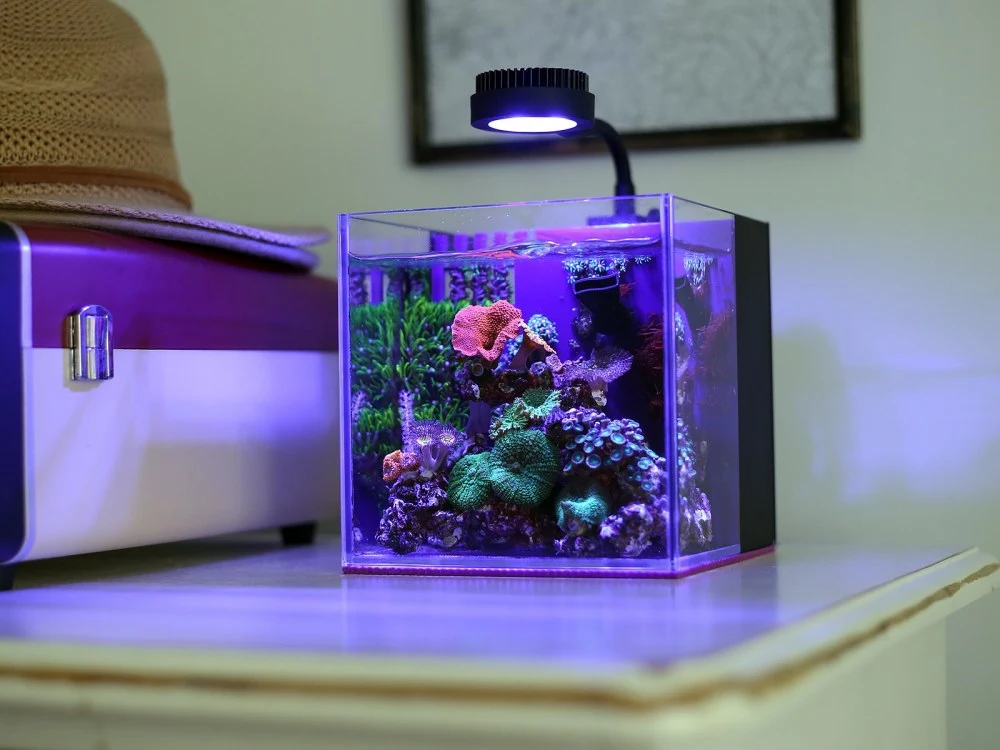Stunning 0-Gallon Reef Tank – SaltyGallon's TOTM | NanoReef

Tank Specifications
Volume: 0 Gallons / 3 Liters
Dimensions (L × W × H):
5.9" ×
5.9" ×
5.9"
15.0cm ×
15.0cm ×
15.0cm
Equipment List
No equipment information available
Frequently Asked Questions
What type of lighting is suitable for a pico reef tank?
For a pico reef tank like SaltyGallon’s, a high-quality LED light, such as the TMC iLumenAir Nano+ Multi Spectrum 3w LED, provides adequate brightness while being energy efficient. This light supports coral photosynthesis and enhances the color of the tank's inhabitants.
How do I maintain stable temperature in a pico reef tank?
Maintaining temperature stability is crucial. It's suggested to use a temperature controller like the Inkbird ITC-306A WiFi for monitoring. Additionally, employing a USB fan to help dissipate excess heat is effective, especially during warm weather. A good-fitting glass cover with ventilation holes also helps manage evaporation and keeps salinity levels stable.
Is a skimmer necessary for a small reef tank?
In SaltyGallon’s setup, no protein skimmer is used. Many pico reef keepers find that with careful feeding and water maintenance, a skimmer is not essential. A reliable filtration method, using sponge and media like carbon and GFO, may suffice for such small tanks.
What is an effective water change routine for a pico reef?
Initially, SaltyGallon performed 100% water changes bi-weekly, but this has evolved into about 10-20% changes every three weeks to once a month, depending on water quality. Observing coral health can guide the frequency of changes. Consider using a turkey baster to remove detritus during water changes for better tank cleanliness.
How often should filter media be changed or cleaned?
SaltyGallon changes carbon and GFO monthly, using three teaspoons of carbon and a pinch of GFO. The sponge used for filtration should be rinsed every couple of weeks or when it becomes visibly dirty to ensure optimal filtration performance.
What do you feed a pico reef tank, and how often?
Feeding can include phyto bought from online sources, given two to three times a week, alongside feeding corals with products like Polyp Lab Reef Roids weekly. Additionally, small pellets can be given to invertebrates after water changes.
What type of corals is recommended for a beginner pico reef?
For newcomers, sticking to hardy soft corals like Rhodactis mushrooms and Zoanthids, as practiced by SaltyGallon, is advised. These types are generally easier to care for, comfortable in varying conditions, and tend to thrive in small ecosystems.
What can I do if I notice detritus build-up in my pico tank?
Utilizing a turkey baster, you can gently blow detritus off surfaces and suck it out during water changes. Regularly cleaning the glass and maintaining a consistent feeding schedule can also help minimize build-up.
How can I prevent algae blooms in a pico aquarium?
Keeping up with regular water changes and being cautious with the amount of food you add can help avoid excess nutrients that promote algae growth. Additionally, monitoring your tank for any pest algae and removing them promptly is important.